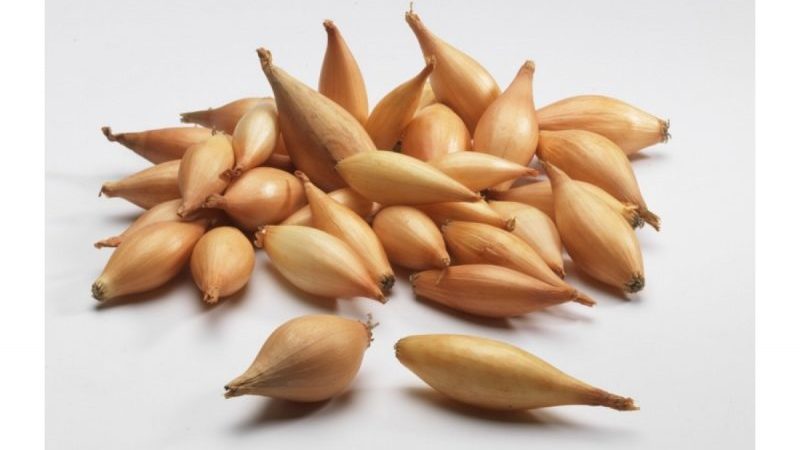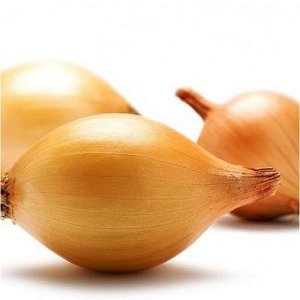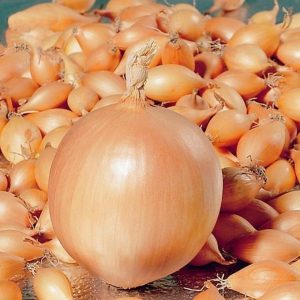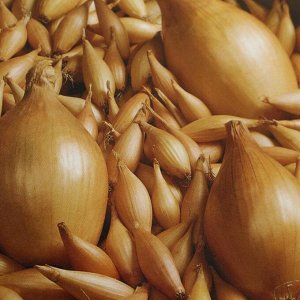An early ripe onion variety "Olina" with excellent yield and excellent taste
Winter onion variety Olina will certainly delight you with an early harvest. Among other early-ripening onion varieties, this particular crop deserves special attention. It is distinguished by almost 100% ripening, excellent semi-sharp taste and unpretentious care.
The content of the article
Description of the variety
Onions can be grown as an annual crop from seeds, and a two-year crop from seedlings.
Let's consider the main features of the variety in more detail.
Origin and development
Olin was bred by Czech breeders of the AGROFIRMA MORAVOSEED company.
It was included in the state register of Russia in 1997. The originator of the variety is IE Alekshasova Marina Vitalievna.
Chemical composition, vitamins, beneficial properties
Onions have pronounced bactericidal properties. It is often used to fight colds and colds.

The chemical composition of Olin onions per 100 g:
- calcium - 31 mg;
- phosphorus - 58 mg;
- sodium - 18 mg;
- magnesium - 14 mg;
- potassium - 175 mg;
- cobalt - 0.8 mg;
- manganese - 0.23 mg;
- copper - 85 mcg;
- fluorine - 30 mcg.
Vitamins:
- B1 - 0.05 mg;
- B2 - 0.02 mg;
- B5 - 0.1 mg;
- B6 - 0.2 mg;
- B9 - 53 mcg;
- C - 10 mg;
- E - 0.2 mg.
Nutritional value per 100 g:
- calorie content - 41 kcal;
- proteins - 1.7 g;
- fats - 1.2 g;
- carbohydrates - 10.5 g;
- water - 87 g.
The vegetable also contains essential oils, sugars, and malic and citric acids.
Important! Fresh onion compress will help treat minor burns and minor wounds.
Ripening period and yield
The variety is early maturing. The period from sowing to harvest when grown from seeds is 67-96 days, and from seedlings - 60-87 days.
From 1 hectare of plantings, when grown from seeds, 67-150 centners of onions are obtained. If the variety is cultivated from seedlings, then about 300 centners are harvested from 1 hectare, and from 1 sq. m - up to 3.5 kg.
Disease resistance
Olin's bow has immunity:
- to fusarium;
- yellow dwarfism;
- mosaic.
Most often, the variety is attacked by fungal diseases: powdery mildew and root rot.
Description of appearance
The bulbs have the following features:
- round shape, like a ball;
- outer scales are dense, hard, yellow or brown, in the amount of two;
- inner scales are white juicy;
- each bulb has 2-3 buds;
- weight - 50-100 g.
The flesh of the onion is dense, the taste is pleasant - semi-sharp.
Landing region
The variety can be cultivated in the Central and Middle Volga regions. This includes the Bryansk, Vladimir, Ivanovsk, Kaluga, Moscow, Ryazan, Smolensk, Tula regions, the Republic of Mordovia, Penza, Samara regions, as well as the Republic of Tatarstan and the Ulyanovsk region.
The main advantages and disadvantages of the variety
Olina has many positive qualities:
- early maturity;
- excellent taste characteristics;
- lack of arrows;
- a large percentage of ripening - 80-90%, and after ripening - 100%;
- resistance to many diseases.
Of the minuses, the variety has a short shelf life. Subject to all conditions, the bulbs are stored for six months.
Features of planting and growing
The Olin variety can be planted in early spring, or sowed before winter.We will tell you in more detail how to do this.
Preparing for landing
Growing from seed is the most common method for producing tasty and juicy large bulbs.
For planting, it is better to use medium-diameter bulbs - 1-3 cm.
Attention. Be sure to check the planting material for rot, damage or disease.
14 days before planting, it is advisable to warm the seedlings at a temperature of +40 ... + 45 ° С for at least 6-8 hours. Immediately before planting, the onions are soaked in a solution of potassium permanganate for 30 minutes, and then treated with any biofungicidal agent for 60-120 minutes.
Do not forget to observe crop rotation when growing a crop. The best predecessors for onions will be the following plants:
- cereals, except oats;
- cabbage;
- mustard;
- rape;
- legumes.
But the bad predecessors are: oats, garlic, onions, cucumbers.
Ground requirements
The cultivar prefers light, nutritious soil with a neutral acidity level of 5.5 to 6.4. This indicator is measured using special strips that are sold in the household departments. In the case of overestimated indicators, wood ash is added to the soil.
Sour and dense soils are not suitable for Olya. Also, there should be no weed seeds in the soil, as they will inhibit the development of plants.
This vegetable does not like fresh manure. But if the soil is depleted and poorly nutritious, then it is recommended to add rotted organic matter to it.
Timing, scheme and landing rules

The variety is planted when the average temperature is kept within + 5 ° C. If the seed is planted earlier, then the bulbs will be small, and with late planting, the bulbs will not have time to germinate before the onset of frost.
The approximate planting time for the Central Region is the end of October or the beginning of November. But if the variety is planted in the Urals or Siberia, then the dates are shifted by about a month, that is, September-October.
Planting can be carried out in the spring, but then the harvest will be poor.
The landing pattern is as follows:
- furrows are made in the garden, leaving 20-25 cm between them;
- the seedlings are planted at a distance of 4-5 cm from each other, the seeding depth is 1-2 cm;
- plantings are sprinkled with earth, compacted, and then watered;
- after which the bed is mulched with dry grass or leaves;
It is important that the seedbed is in a dry and unshaded place. Its height should be 15-20 cm.
Growing features
It is better to place the site for onions at a certain elevation, this will enable the culture to receive more sunlight.
Olin is considered a frost-resistant variety - the most comfortable temperature for it will be from +12 to + 16 ° С.
Important! In order for the bulbs to develop well, the variety needs a sufficient amount of moisture, otherwise the onions will be small and not juicy.
Try to protect the garden from strong winds and drafts. They adversely affect plants and their growth.
The nuances of care
When cultivating a variety, proper care is important. Onions need timely watering, weeding, and fertilization.
Watering mode
Be sure to maintain a balance of soil moisture. The earth should not be overdried or, on the contrary, waterlogged. After planting for 3-4 weeks, onions especially need moisture, so try to prevent the soil from drying out.
Plantings are watered once every 10 days, and in case of severe drought - once every 5-7 days. First, the soil is moistened to a depth of 10 cm, but as the bulbs grow, the volume of water is increased, soaking the soil to 20-25 cm. The frequency remains the same.
Attention. It is necessary to water the plantings in the morning or evening hours. Pour water nearby so as not to burn the onions.
Watering is stopped about 3-4 weeks before harvesting.
Loosening the soil and weeding
These measures are required when growing the Olin variety.
Weeding from weeds is carried out every 15 -20 days. Weeds create additional moisture in the garden, which contributes to the development of fungal diseases. If the onion areas are not cleared of grass, then it grows with a thick and juicy neck. This makes drying more difficult and shortens shelf life.
To provide the roots with nutrition and moisture, you need to periodically loosen the soil. It also reduces weeds and gives more space for bulb growth.
In order not to form a crust, it is advisable to loosen the soil after each watering.
Top dressing
For the entire growing season, onions are fed at least three times.
Attention. When applying dressings, it is better not to use mixtures with nitrogen, as they lead to the growth of green mass, and the bulbs will be small.
Fertilizers are applied according to the following scheme:
- The first time the onion is fertilized 2-3 weeks after germination, when the plants reach a height of 2-3 cm. Urea is used for feeding. For 60 g of the drug, 10 liters of water are taken. The resulting solution is poured under the root.
- The second time is fed 21 days after the first time. To do this, use a composition prepared from 40 g of superphosphate, 10 g of potassium salt and 20 liters of water.
- The third time the onion is fertilized a month before the tops are lodged. Phosphorus-potassium preparations are used. They are brought in strictly according to the instructions.
The first feeding is needed to stimulate the roots and develop greenery. The second and third are for feeding the bulbs and increasing their mass.
Disease and pest control
Diseasesthe variety is susceptible to:
- Root rot. It is characterized by the appearance of yellow spots or dry patches on green feathers. The fight is carried out by preparing a solution. For 20 liters of water, 2 tbsp is taken. l. copper sulfate and 2 tbsp. l. grated laundry soap. You can process it when the tops grow up to 12 cm.
- Powdery mildew. Damages leaves and bulbs. As a prophylaxis and fight against the disease, dusting of plants and soil with wood ash or tobacco dust is used.
Among pests the most dangerous are:
- Onion fly... The insect lays the larvae in onion plantings. Then they eat into the cervix and stop its development. Ways of struggle - mulching or Fitoverm.
- Nematodes... They look like small worms that feed on onion juice. To get rid of them, observe the crop rotation and be sure to process the seeds before planting.
- Thrips. Bulbs infested with thrips become wrinkled under the scaly layer. The harm from them is tangible. You can notice their presence by the yellowed tops. It starts to deteriorate from the top. Pest control is difficult, so prevention is of particular importance. Plant only tested and treated seed, observe crop rotation, do not overmoisten the soil.
Remember that when growing onions on a feather, do not use chemicals. All treatments are carried out at least one month before harvest.
Harvesting and storage

After the end of the growing season, harvesting begins.
How and when to collect
The variety is considered early maturing. Harvesting usually begins in late August or early September. You can determine the readiness of the onion for harvesting by the yellowed and dried tops.
It is advisable to choose a dry and sunny day. The vegetables are dug up with a shovel or gently pulled out by hand. The harvested crop is dried in a warm place under sunlight for a week.
Periodically, the bulbs are turned over to dry evenly. At the same time, the roots and stem residues are removed.
Storage features and keeping quality of the variety
Dried and selected bulbs are placed for another week for re-drying in a heated room. After that, the crop is placed in wooden or plastic boxes in several layers. You can arrange the onions in nets or cloth bags.
Important! The variety has good keeping quality - 90-95%.
Store Olin's onions in a dry, ventilated place at a temperature of 0 ... -1 ° C. Air humidity 75-90%. Subject to all the rules, the onions are stored for 6 months.
Growing difficulties
When cultivating a variety, some problems may arise:
- the appearance of fungal diseases;
- obligatory soil moisture test.
Make sure that the variety is not attacked by pests.
Tips from experienced gardeners
Onions love feeding in the form of yeast infusion... For this, 50 g of yeast is diluted in 5 liters of water. The mixture is infused for 60 minutes. First, the plantings are watered with water, then the resulting solution.
Some summer residents advise soaking the sevok in a strong saline solution for 3 hours before planting. A tablespoon of salt is taken in a glass of water. Then the onion is placed in a solution of potassium permanganate.
Reviews
Many gardeners liked this variety. Its value is in early harvest, smooth bulbs and high ripeness.
Yaroslav, Oryol: “The Olin variety came across to me by accident. I planted it in the winter. In the spring, my seedbed was green. The harvest was good, because in the fall I prepared the soil, fertilizing it with minerals ”.
Evgeniya, Saratov: “This onion was recommended to me by a friend. I decided to try to plant it and was right. His maturity is excellent. The taste is mild, we really liked it. Of the fertilizers I used wood ash and potash salt. "
Conclusion
Olin's bow has become a favorite with many farmers and gardeners. Its smooth, medium-sized bulbs are consistently popular. The variety is early maturing, resistant to a number of diseases. Subject to the necessary agricultural technology, it will not be difficult to get a large harvest.